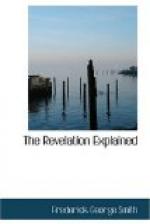But Christ, who in chapter 1:5 is said to be “the faithful witness,” will not overlook anything that is good, nor censure a congregation unjustly. He finds in this church one fact worthy of commendation—their abhorrence of the deeds of the Nicolaitans. The infamous practises attributed to this party are promiscuous sexual intercourse and the eating of things sacrificed to idols. It is said to have derived its name from Nicolas, a proselyte of Antioch, who was one of the seven deacons appointed by the church at Jerusalem, Acts 6:5. But there is no satisfactory evidence that Nicolas was its founder; and it is the belief of many, that the sect attributed their origin to him simply to gain the prestige of his name. However, its mention in this connection is sufficient proof that at this time those corrupt principles had been widely promulgated.
The letter closes with an admonition and a promise—an admonition to give heed to the things uttered by the Spirit, and a promise of everlasting life to the overcomer. This shows that Christ does not approve or condemn indiscriminately. If the great mass of professors continue in their backslidden condition, the individual that gives heed to God’s Word and is made an overcomer will have a right to “the tree of life, which is in the midst of the paradise of God.”
What, may we ask, has been the fate of this church against which Christ uttered the threat of removal? There is no proof that they gave heed to the exhortation to repent, and the candle-stick has long since been taken away. Not a vestige of a church remains to mark the site of this once important congregation; nay, the city itself is no more, the stork, the jackal, and a few miserable Turkish huts alone remaining on the site of this once proud metropolis where thousands congregated and cried, “Great is Diana of the Ephesians!”




